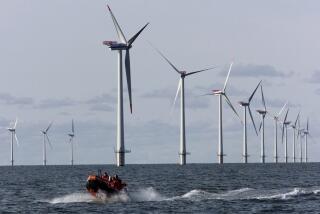Massachusetts tribes aim to take the wind out of a wind farm
- Share via
Reporting from Oak Bluffs, Mass. — The Wampanoag Indians of southeastern Massachusetts welcomed the Pilgrims when they arrived on the Mayflower nearly 400 years ago. But now they’re trying to stop another newcomer -- wind turbines.
Citing customs and religious practices recorded since the earliest contact with Europeans, two local tribes have blocked, at least for now, America’s first planned offshore wind farm and the Obama administration’s efforts to promote renewable sources of energy.
At issue is a private developer’s plan to erect 130 wind turbine generators on a sandy shoal in the middle of Nantucket Sound, the scenic channel between Cape Cod and the resort islands of Martha’s Vineyard and Nantucket.
Federal approval for Cape Wind, as the project is known, finally appeared on the horizon last fall after nine years of political battles, court challenges and regulatory reviews.
But then the indigenous tribes won an unexpected victory. On Jan. 4, the National Park Service ruled in favor of the Wampanoags that Nantucket Sound is eligible for listing on the National Register of Historic Places as a “traditional cultural property,” and thus is worthy of preservation.
The park service said the 440-foot-high towers would interfere with Wampanoag spiritual ceremonies, including greeting the sunrise with unobstructed views of the water.
The ruling also said excavations for the towers could disturb presumed Indian burial grounds that began to disappear under rising seas about 6,000 years ago. The shoal is now 30 feet beneath the waves.
The tribes, the Mashpee Wampanoag of Cape Cod and the Aquinnah Wampanoag of Martha’s Vineyard, “emphasize that they believe that their people traversed, lived on and buried their dead, and otherwise used the land . . . before the land was submerged,” the park service said.
Mark Rodgers, spokesman for Cape Wind Associates, the developer, said seabed borings and other underwater tests on Horseshoe Shoal, where the towers would rise, found vegetative matter and “the head of a bug,” but “no evidence of human artifacts.”
“We think that addresses the issue of it being a burial ground for their ancestors,” he said. “It’s not a game changer.”
The park service ruling kicked the final decision to Ken Salazar, the U.S. secretary of the interior. After watching the sunrise from a cold beach with several Mashpee Wampanoags, and riding a Coast Guard cutter across the shoal, Salazar said he would decide by the end of April whether to allow Cape Wind to proceed.
“He can decide up or down,” said Frank Quimby, Salazar’s spokesman. “The only position he’s taken is, nine years and counting is a ridiculous amount of time to wait for a decision. It shouldn’t be strung out indefinitely.”
The Wampanoags and other opponents are expected to mount a spirited defense. “We’re going to fight this all the way,” said Buddy Vanderhoop, a Wampanoag from Aquinnah and skipper of a charter fishing boat called the Tomahawk. “This is sacred ground for us.”
Not every tribal member agrees. The two tribes claim about 2,400 enrolled members, although only a few hundred live in the area, and even fewer are active in tribal ceremonies.
Jeffrey Madison, a former member of the Wampanoag tribal council in Aquinnah and lawyer for a firm that represents Cape Wind, called the sunrise ritual a “fabricated cosmology” that was unknown to his father and grandfather, both former medicine men.
“I am stating to you with complete honesty and knowledge that I never participated in, witnessed, or even heard of a sacred spot on the horizon that is relevant to any Aquinnah Wampanoag culture, history or ceremony,” Madison wrote to Salazar during the public comments period.
President Obama has championed development of wind energy to help counter global warming, and the case has become a critical test of his administration’s priorities.
The president, who vacationed last summer on Martha’s Vineyard, has not publicly taken sides in the dispute.
Supporters of Cape Wind, including most national environmental groups, said the project would help supply clean electricity and lead the way for proposed wind farms off the coasts of New York, New Jersey, Delaware and other states.
Opponents argued that the turbines would hurt fishing, endanger aircraft, lead to higher utility rates and cripple tourism.
Five miles offshore, the huge towers and churning blades would line the horizon from many beaches and towns.
“You name the problem, this project has it,” complained Audra Parker, president of the Alliance to Protect Nantucket Sound, the main opposition group.
She and other critics have urged Cape Wind to move the wind farm to a deeper, more exposed site off Tuckernuck Island, about 10 miles away in the open Atlantic.
“It means throwing a decade away,” countered Rodgers, the Cape Wind spokesman. “If someone else wants to step forward and look at development of a wind farm out there, that’s great. They’ve got a lot of work ahead of them.”
Whatever happens, the issue has energized local Wampanoags and rekindled interest in their culture and history.
When Europeans first arrived, the Wampanoags comprised several dozen tribes and about 12,000 members who farmed, fished and hunted from coastal villages.
“We’re the ones who were there when the first Pilgrims arrived,” said tribal leader Cheryl Andrews-Maltais, tribal chairwoman in Aquinnah, referring to the bedraggled immigrants who came on the Mayflower in November 1620. “We met them on the shore. That was us.”
Andrews-Maltais sees an irony in her forebearers’ welcome to the Puritans and others who sailed to the New World to escape oppression.
“Here we are fighting for our religious freedom from the same people who came here to find religious freedom,” she said. “I’m just hoping we have the same rights they do.”
More to Read
Sign up for Essential California
The most important California stories and recommendations in your inbox every morning.
You may occasionally receive promotional content from the Los Angeles Times.














